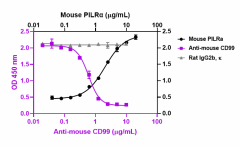- Clone
- W20091C (See other available formats)
- Regulatory Status
- RUO
- Other Names
- CD99, MIC2, HBA71, MSK5X, E2 antigen
- Isotype
- Rat IgG2b, κ
- Ave. Rating
- Submit a Review
- Product Citations
- publications

-

Recombinant mouse PILRα (Cat. No. 792806) (black circles) binds to immobilized recombinant mouse CD99. Ultra-LEAF™ purified anti-mouse CD99 (clone W20091C) (purple squares) inhibits the binding in a dose-dependent manner, whereas the GoInVivo™ purified rat IgG2b, κ isotype control (Cat. No. 400666) (gray triangles) does not have the effect. This antibody blocks the binding of 7.5 µg/mL recombinant mouse PILRα to 5 µg/mL immobilized recombinant mouse CD99. ND50 range: 0.4 - 2 µg/mL.
| Cat # | Size | Price | Save |
|---|---|---|---|
| 604253 | 100 µg | ¥68,560 | |
| 604254 | 1 mg | ¥200,030 |
CD99 is a type I single chain transmembrane protein devoid of N-linked glycosylation sites encoded by the pseudoautosomal gene MIC2. CD99 has an apparent molecular weight of 32 kD and is widely expressed on a variety of tissues. CD99 is highly expressed on thymocytes, T cells, and T cell leukemias and lymphomas. However, it is absent on some B cell lines, fetal B cells, eosinophils, granulocytes, and the NK-cell line YT. CD99 is involved in spontaneous rosette formation with erythrocytes and may also be involved in other T-cell and hematopoietic cell adhesion pathways. CD99 has been reported to activate a caspase-independent death pathway in T cells under some conditions. CD99 interacts with a number of proteins including ferritin heavy chain 1, karyopherin beta 1, TRIP13, cyclophilin A, annexin II, and ubiquitin-conjugating enzyme E2H.
Product DetailsProduct Details
- Verified Reactivity
- Mouse
- Antibody Type
- Monoclonal
- Host Species
- Rat
- Immunogen
- Recombinant mouse CD99
- Formulation
- 0.2 µm filtered in phosphate-buffered solution, pH 7.2, containing no preservative.
- Endotoxin Level
- Less than 0.01 EU/µg of the protein (< 0.001 ng/µg of the protein) as determined by the LAL test.
- Preparation
- The Ultra-LEAF™ (Low Endotoxin, Azide-Free) antibody was purified by affinity chromatography.
- Concentration
- The antibody is bottled at the concentration indicated on the vial, typically between 2 mg/mL and 3 mg/mL. To obtain lot-specific concentration and expiration, please enter the lot number in our Certificate of Analysis online tool.
- Storage & Handling
- The antibody solution should be stored undiluted between 2°C and 8°C. This Ultra-LEAF™ solution contains no preservative; handle under aseptic conditions.
- Application
-
Block - Quality tested
- Recommended Usage
-
Each lot of this antibody is quality control tested by blocking the binding of 7.5 µg/mL recombinant mouse PILRα (Cat. No. 792806) to 5 µg/mL immobilized recombinant mCD99. ND50 range: 0.4 - 2.0 µg/mL. It is recommended that the reagent be titrated for optimal performance for each application.
- RRID
-
AB_2922637 (BioLegend Cat. No. 604253)
AB_2922637 (BioLegend Cat. No. 604254)
Antigen Details
- Structure
- Disulfide-linked homodimer
- Distribution
-
T-cells, thymocytes, T-cell leukemias and lymphomas. It is absent on fetal B-cells, eosinophils, granulocytes, and NK cell line YT.
- Function
- Leukocyte migration, T-cell adhesion, caspase independent T-cell death, and spontaneous rosette formation with erythrocytes
- Interaction
- Annexin II, E2H, Ferritin heavy chain 1, karyopherin beta 1, and TRIP13
- Ligand/Receptor
- PILR-alpha and PILR-beta
- Cell Type
- B cells, Basophils, Dendritic cells, Fibroblasts, Macrophages, Mast cells, NK cells, Platelets, T cells
- Biology Area
- Immunology
- Molecular Family
- CD Molecules
- Antigen References
-
- Gelin C, et al. 1989. EMBO J. 8:3253-59.
- Goodfellow PJ, et al. 1986. Science. 234:740-43.
- Pettersen RD, et al. 2001. J. Immunol. 166:4931-42
- Gene ID
- 673094 View all products for this Gene ID
- UniProt
- View information about CD99 on UniProt.org
Related FAQs
- Do you guarantee that your antibodies are totally pathogen free?
-
BioLegend does not test for pathogens in-house aside from the GoInVivo™ product line. However, upon request, this can be tested on a custom basis with an outside, independent laboratory.
- Does BioLegend test each Ultra-LEAF™ antibody by functional assay?
-
No, BioLegend does not test Ultra-LEAF™ antibodies by functional assays unless otherwise indicated. Due to the possible complexities and variations of uses of biofunctional antibodies in different assays and because of the large product portfolio, BioLegend does not currently perform functional assays as a routine QC for the antibodies. However, we do provide references in which the antibodies were used for functional assays and we do perform QC to verify the specificity and quality of the antibody based on our strict specification criteria.
- Does BioLegend test each Ultra-LEAF™ antibody for potential pathogens?
-
No, BioLegend does not test for pathogens in-house unless otherwise indicated. However, we can recommend an outside vendor to perform this testing as needed.
- Have you tested this Ultra-LEAF™ antibody for in vivo or in vitro applications?
-
We don't test our antibodies for in vivo or in vitro applications unless otherwise indicated. Depending on the product, the TDS may describe literature supporting usage of a particular product for bioassay. It may be best to further consult the literature to find clone specific information.
Other Formats
View All CD99 Reagents Request Custom Conjugation| Description | Clone | Applications |
|---|---|---|
| Ultra-LEAF™ Purified anti-mouse CD99 | W20091C | Block |
Compare Data Across All Formats
This data display is provided for general comparisons between formats.
Your actual data may vary due to variations in samples, target cells, instruments and their settings, staining conditions, and other factors.
If you need assistance with selecting the best format contact our expert technical support team.
-
Ultra-LEAF™ Purified anti-mouse CD99

Recombinant mouse PILRα (Cat. No. 792806) (black circles) bi...










Follow Us